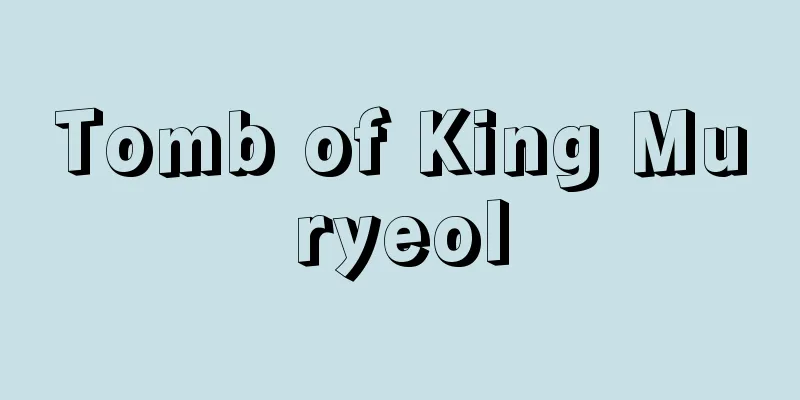Tomb of King Muryeol

|
The tomb of King Muyeol (died 661), the 29th king of Silla, is located at the foot of a mountain in Seoak-dong, Gyeongju, South Korea. It is the only ancient tomb of the Silla royal tombs from the Three Kingdoms period whose buried person can be identified with certainty. It is a circular tomb with a base diameter of about 32 meters and a height of about 13 meters, with a stone bed placed in front of the tomb and broken stones around the base of the mound. There is a tombstone on the east front of the tomb, but now only the granite tortoise base and head remain, and the body of the tomb has disappeared. The tortoise base has a treasure flower pattern above and below the neck, a tortoise shell pattern on the back and flying cloud pattern around the edge, and a base for the body of the tomb surrounded by lotus flowers in the center of the back. The tomb depicts six dragons grabbing a ball in the center, with a seal in the middle and eight characters "Monument to King Taejong Muyeol" carved in two lines. Both the tortoise base and the tomb were influenced by the early Tang dynasty. During the Unified Silla period, mausoleums and other structures came to follow the Tang system, but King Muryeol's tomb still retains the Silla tomb system of the Three Kingdoms period, suggesting that its final period roughly coincides with the time of Silla's unification of the peninsula. [Hideo Sadamori] Burial mound. The stone floor can be seen slightly left of the center. Broken stones have been placed at the base of the mound to prevent it from collapsing. Gyeongju, Korea ©Shogakukan "> Tomb of King Muyeol The body of the monument is gone, but only the base and head remain. Gyeongju, Korea ©Shogakukan "> Monument at the Tomb of King Muyeol Source: Shogakukan Encyclopedia Nipponica About Encyclopedia Nipponica Information | Legend |
|
韓国(大韓民国)、慶州市西岳洞の山麓(さんろく)にある新羅(しらぎ)第29代の武烈王(661没)の陵墓。三国時代新羅の王陵中、確実に被葬者がわかる唯一の古墳である。底径約32メートル、高さ約13メートルの円墳で、陵前に石床が置かれ、墳丘の裾(すそ)には割り石が巡らされている。陵の前方東側に陵碑があるが、現在は花崗(かこう)岩製の亀趺(きふ)と螭首(ちしゅ)が残っているだけで、碑身はなくなっている。亀趺は、頭上と頸下(けいか)に宝相華(ほうそうげ)文、背に亀甲(きっこう)文とその縁に飛雲文が配され、背中央に蓮華(れんげ)を巡らした碑身の座を有する。螭首は六龍が中央の球をとるようすを表し、中間に篆額(てんがく)があり、「太宗武烈大王之碑」の8字が2行に陽刻されている。これらの亀趺、螭首はともに初唐の影響を受けたものである。統一新羅時代には陵墓などは唐制を踏襲するようになるが、武烈王陵は三国時代新羅墓制をまだもっていて、その終末期が新羅の半島統一前後とほぼ一致することを示唆している。 [定森秀夫] 墳丘。中央やや左に石床が見える。墳丘の裾には崩壊を防ぐための割り石が置かれている。韓国 慶州©Shogakukan"> 武烈王陵 碑身はなく、亀趺と螭首が残っている。韓国 慶州©Shogakukan"> 武烈王陵の陵碑 出典 小学館 日本大百科全書(ニッポニカ)日本大百科全書(ニッポニカ)について 情報 | 凡例 |
<<: Flextime system - Flextime system
Recommend
Boulder Dam
…A gravity arch dam was completed in 1935 in the ...
Space industry
...The aerospace industry originally developed as...
Street Preaching - Tsujiseppo
A method of Buddhist evangelism in which one stan...
Polymer gasoline
…When there is a high demand for gasoline, the re...
Berger mixture
… Smoke is used as a concealment screen and as a ...
Drepanididae
…A general term for birds of the passerine order,...
Allomorph
…In this way, morphemes can take different forms ...
Astrodome (English spelling)
The world's first covered baseball stadium was...
Chronicle of Prosperity
A genre of Chinese comic stories that was popular ...
Fasci italiani di combattimento
...Let us consider the history and nature of Ital...
Hiden-in
〘Noun〙① A facility built to house orphans and the ...
Fumoto Village - Fumotoshuraku
A settlement of local samurai living in the area o...
Ishiwaki
…Southwestern Akita Prefecture, a plain downstrea...
sharp
…The notes in the basic scale (C major scale, i.e...
Sweet tonsils - Kantonto
… Next, let us talk about the ingredient variatio...



![Kasai [river] - Kasai](/upload/images/67cb311c8f781.webp)





